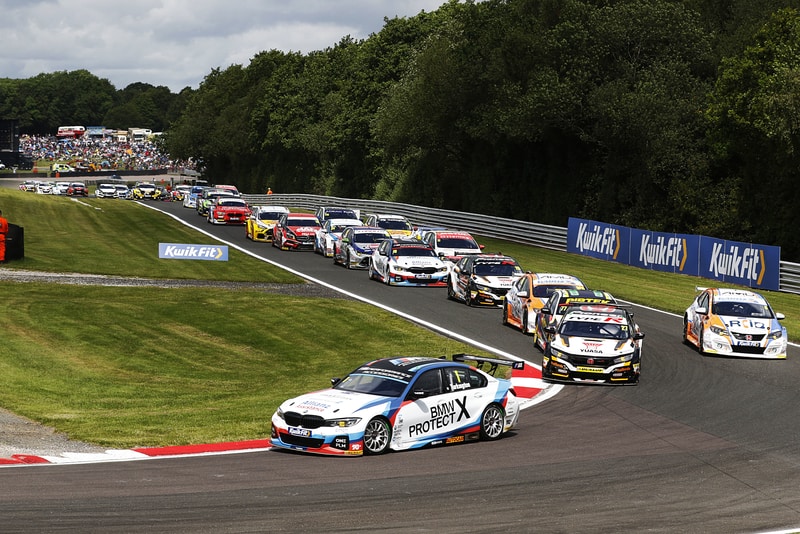
BTCC: New Hybrid Rules Announced; No more Success Ballast
Cosworth Electronics have been named as the British Touring Car Championship’s new hybrid system provider when hybrid technology is introduced in 2022.
The move means that success ballast will no longer be used since drivers will now be able to use an additional hybrid boost power to defend and attack each other – similar to the KERS system that Formula One used to use in the latter stages if the V8 engine era.
A 60-volt system has been designed by Cosworth Electronics and will weigh no more than 64KG. Weight and ballast no longer matters since the leading cars will be restricted to the amount of additional hybrid power compared to other runners.
After the first lap, drivers will be able to control the amount of hybrid energy they want to use or regenerate throughout the race. The driver will have a button on the steering wheel to engage the additional hybrid power once the car has hit full traction and this will deactivate when the drivers presses the button again or after using the brakes or when the time or energy limit has been reached.
Drivers will be able to use the additional hybrid power anywhere at anytime so it is a system that is very similar to the push to pass system that IndyCar successfully uses.
In its purest form, the power gain will be available for a maximum of 15 seconds per lap with an additional power gain of 40BHP.
There is no limit as to how often the button can be pressed over one lap.
When the driver activates the system, an LED light will display on the car. Each vehicle must be able to travel the length of the pitlane under electric power.
Summary
- 60V system, 64kg total – takes the place of success ballast
- Used as ‘Push-to-pass’ of around +40bhp for 15 seconds per lap
- Full length of pitlane under electric power
- Configurable hybrid output/regeneration rate will replace success ballast weight
- Completely bolt on to current engines so no changes there either in power or sound
I think it is fantastic to introduce this system and BTCC is able to follow other motorsports in terms of technology yet will be able to keep some of the traditional functions such as the sound and the current NGTC configuration of car.
The annual cost of the system is just £20,500 a year and means that there is now a five year extension to the current NGTC regulations until 2026. If this interests a few more fully backed manufacturers to return or make their debut to the championship then it can only be good for the BTCC which already has a grid of 30 cars.
As for the success ballast, it is nice to see a change. The BTCC could so easily have stuck with it but decided to make a bold and brave decision to go away from it and use technology to create close competition and brilliant racing.
If anything, this change will create even better racing with an element of strategy now involved. It puts a little more emphasis on the drivers to intelligently use their hybrid energy to defend or attack. The drivers should be the main act for the viewer and this move will demonstrate which driver can use their skill, racecraft and wit to make overtakes or defend from a rival.
Once again, the BTCC has got it right.



![Private: [ID: 71rYi-xncgM] Youtube Automatic](https://motorradio-xijqc.projectbeta.co.uk/wp-content/uploads/2024/08/private-id-71ryi-xncgm-youtube-a-1-360x203.jpg)
![Private: [ID: 1SfHxvC8Doo] Youtube Automatic](https://motorradio-xijqc.projectbeta.co.uk/wp-content/uploads/2024/07/private-id-1sfhxvc8doo-youtube-a-1.jpg)
![Private: [ID: H6XRkf6kROQ] Youtube Automatic](https://motorradio-xijqc.projectbeta.co.uk/wp-content/uploads/2024/07/private-id-h6xrkf6kroq-youtube-a-1-360x203.jpg)
![Private: [ID: Kb6w-qAmKls] Youtube Automatic](https://motorradio-xijqc.projectbeta.co.uk/wp-content/uploads/2023/12/private-id-kb6w-qamkls-youtube-a-360x203.jpg)
![Private: [ID: CcpwYw20k3k] Youtube Automatic](https://motorradio-xijqc.projectbeta.co.uk/wp-content/uploads/2024/07/private-id-ccpwyw20k3k-youtube-a-360x203.jpg)

![[ID: x1SiRC5jhW4] Youtube Automatic](https://motorradio-xijqc.projectbeta.co.uk/wp-content/uploads/2022/04/id-x1sirc5jhw4-youtube-automatic-360x203.jpg)
![[ID: lMZ8lAeLubk] Youtube Automatic](https://motorradio-xijqc.projectbeta.co.uk/wp-content/uploads/2022/04/id-lmz8laelubk-youtube-automatic-360x203.jpg)
![[ID: GAYCcnqyFo4] Youtube Automatic](https://motorradio-xijqc.projectbeta.co.uk/wp-content/uploads/2022/04/id-gayccnqyfo4-youtube-automatic-360x203.jpg)
![[ID: Gg142H296QY] Youtube Automatic](https://motorradio-xijqc.projectbeta.co.uk/wp-content/uploads/2022/04/id-gg142h296qy-youtube-automatic-360x203.jpg)
![Private: [ID: 71rYi-xncgM] Youtube Automatic](https://motorradio-xijqc.projectbeta.co.uk/wp-content/uploads/2024/08/private-id-71ryi-xncgm-youtube-a-1-236x133.jpg)
![Private: [ID: H6XRkf6kROQ] Youtube Automatic](https://motorradio-xijqc.projectbeta.co.uk/wp-content/uploads/2024/07/private-id-h6xrkf6kroq-youtube-a-1-236x133.jpg)
![Private: [ID: Kb6w-qAmKls] Youtube Automatic](https://motorradio-xijqc.projectbeta.co.uk/wp-content/uploads/2023/12/private-id-kb6w-qamkls-youtube-a-236x133.jpg)
![Private: [ID: nc-8g6ROCe8] Youtube Automatic](https://motorradio-xijqc.projectbeta.co.uk/wp-content/uploads/2023/11/private-id-nc-8g6roce8-youtube-a-236x133.jpg)
![Private: [ID: wWrhfjOQuIc] Youtube Automatic](https://motorradio-xijqc.projectbeta.co.uk/wp-content/uploads/2023/11/private-id-wwrhfjoquic-youtube-a-236x133.jpg)